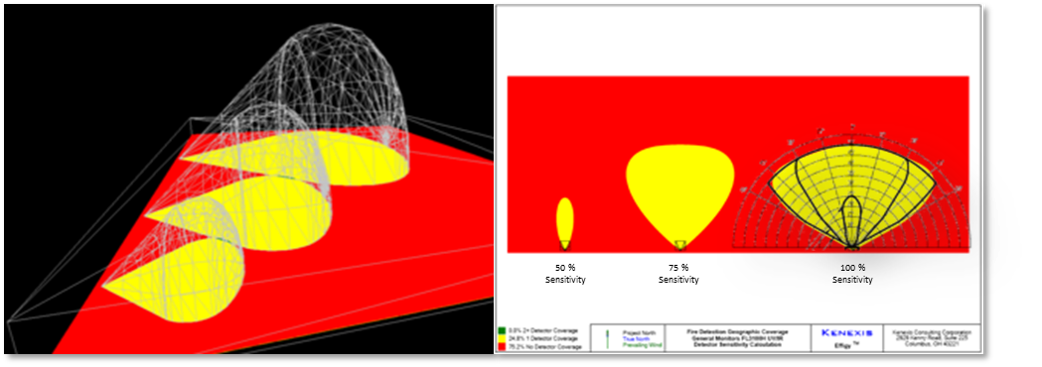How is the “RHO” Setting Used in Fire and Gas Mapping?
When performing fire detection coverage mapping, the capability of a fire detector, as defined by its “cone of vision”, is a function of the size of the fire that the device is attempting to detect. When fire detectors are tested, in conformance with the Factory Mutual 3260 Approval Standard, this fire is a 1 ft x 1 ft pan of n-heptane. This is fine for ensuring consistent reporting of capabilities from vendors, but when designing and installing fire detection systems it is important to understand the capabilities of the fire detector with respect to the fire that is actually expected to occur. If the species that is expected to burn is either not n-heptane, or not effectively represented by n-heptane, then a different cone of vision for that species of fuel must be developed (usually by the equipment vendor). Also, in many cases the actual dimensions of a design basis fire that is expected to occur is not consistent with the 1 ft x 1 ft pan fire for which testing has been performed. In some cases small fires must be detected, such as those from flange leaks or seal leaks at compressors – this type of fire could be only a couple of centimeters at its base when it needs to be detected. In other cases, fire detection does not need to be activated until a fire becomes substantially large, such as a warehouse fire – this type of fire could be effectively controlled even if only detected after its base has expanded to a meter or more.
In order to address the size of a fire in fire detector coverage assessments, more sophisticated software is capable of automatically scaling the dimensions of the cone-of-vision as a function of the size of fire that is desired to be detected. There are a couple of ways to do this activity, but the most commonly used historical method is through defining the size of the fire through its radiant heat output (RHO). The RHO of a design basis fire can be calculated through well established correlations used for chemical process quantitative risk analysis for pool fires. When this type of approach is used on a 1 ft x 1ft n-heptane pool fire, and RHO in the range of 40-50 kW is the result. The amount of thermal heat flux that is experienced at a receptor that is a given distance away from a fire can also be calculated easily with well established equations for radiative heat transfer. This combination of factors allows fire and gas mapping software to be able to estimate the dimensions of the cone of vision for a fire that is different size than 1 ft x 1 ft by calculating the RHO of the expected fire and then scaling the extents of the cone of vision so that the radiative heat flux calculated at the edge of the cone of vision is the same as what would be calculated for the 1 ft x 1 ft n-heptane pan fire. Using this approach, the RHO from a compressor seal fire that is only a couple of centimeters at its base would be about 10 kW whereas a warehouse hire that is about one meter at its base would generate an RHO of about 300 kW. The FGS mapping software would then re-scale a much smaller cone of vision for the 10 kW fire and a much larger cone of vision for the 300 kW fire than the vendor published cone of vision that is based on FM 3260 and its 40-50 kW fire.
While the science behind calculating RHO and then rescaling cones of vision based on the concept of equivalent thermal heat flux at the edge of the cone of vision is proven and reliable (even though most of our competitors cannot do this…), Kenexis is trying to simply the process. In the future, the we expect to remove the requirement for specifying the RHO of the design basis fire, which most practitioners of fire and gas system design do not understand how to calculate, and replacing it with a specification of fire dimensions (e.g., base = 0.3 meters and height = 1.0 meters). This allows the software users to input data in terms that are more relevant to them. Afterward, the FGS would do the work of calculating the RHO that would be expected from a fire with those dimensions, all behind the scenes without the user needing to get involved. You can count on Kenexis to continue to innovate from our industry leading position to make our software even more sophisticated and accurate, but also easier to use.

